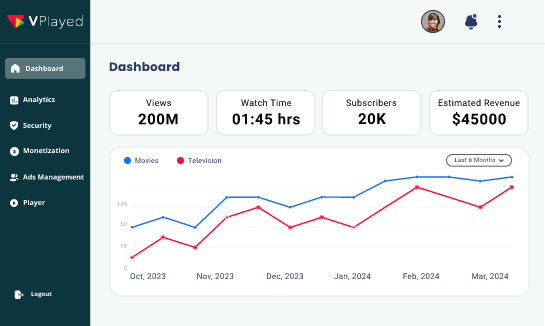Start and Grow Your OTT Streaming Application With 1000+ Features & 10+ Revenue Models.
Book a Free DemoWhat is Linear TV? The Difference Between Linear TV vs OTT
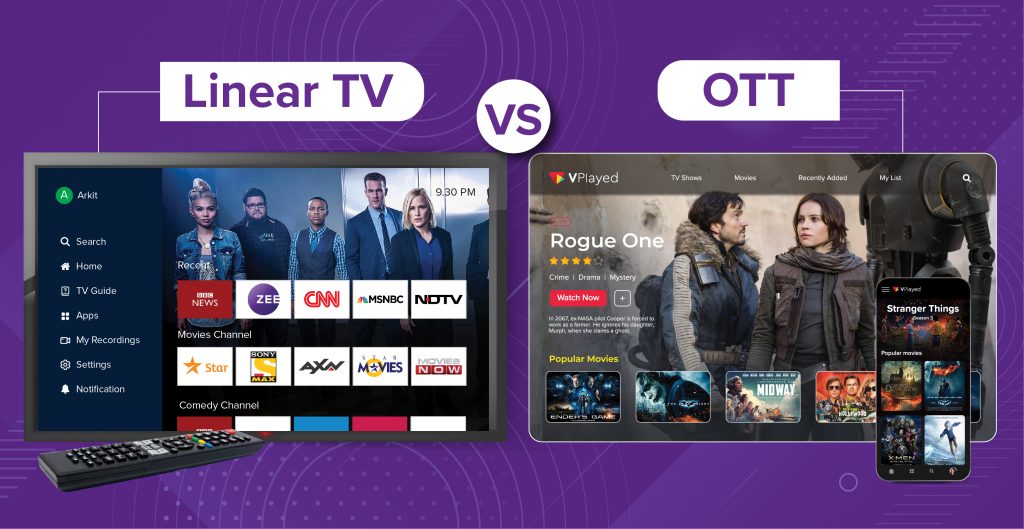
Summarize this article via
The traditional television industry is undergoing significant changes due to the increasing popularity of new content consumption habits among audiences.
This shift is disrupting the entire linear TV market. According to statistics, the majority of linear television viewers fall into the category of older audiences, typically aged 35 or older.
Turning our attention to focus on mighty brands, it is crucial to consider that when contemplating linear TV viewership, these audiences are predominantly associated with affluent groups.
Despite the emergence of newer non-linear TV technology causing a paradigm shift, it has yet to render linear television obsolete.
Furthermore, there is a positive aspect to live TV events, as they attract and engage audiences of all ages, regardless of their geographical location.
On a broader level, these live streaming events tend to capture unique viewing trends compared to any other marketing channel.
Moreover, linear streaming continues to play a significant role in broadcasting events with a broader audience, such as live sports and concerts.
However, it is important to note that non-linear viewing remains in the ascendancy and is poised to receive unprecedented popularity.
Besides that, viewing habits and preferences tend to vary by age group in demographic studies.
In fact, it was later found that audiences who fall under the teenage category are increasingly shifting towards OTT video platform for viewing live events and entertainment purposes.
- Fully Customizable
- Lifetime Ownership
- On-Premise/On-Cloud
- 100% White-label
- Zero Revenue Share
- Hire Developers
Table of Contents
What is Linear TV?
Linear TV is a specific type of television broadcasting that delivers content in a sequential, predetermined program schedule.
It’s the conventional way of receiving satellite signals for television. It is the place where programs are shown at specific times, usually in blocks based on time period (e.g. morning, afternoon, evening).
Linear TV is still very much in use today, particularly in cable and satellite TV systems, though on-demand and streaming options have become increasingly popular.
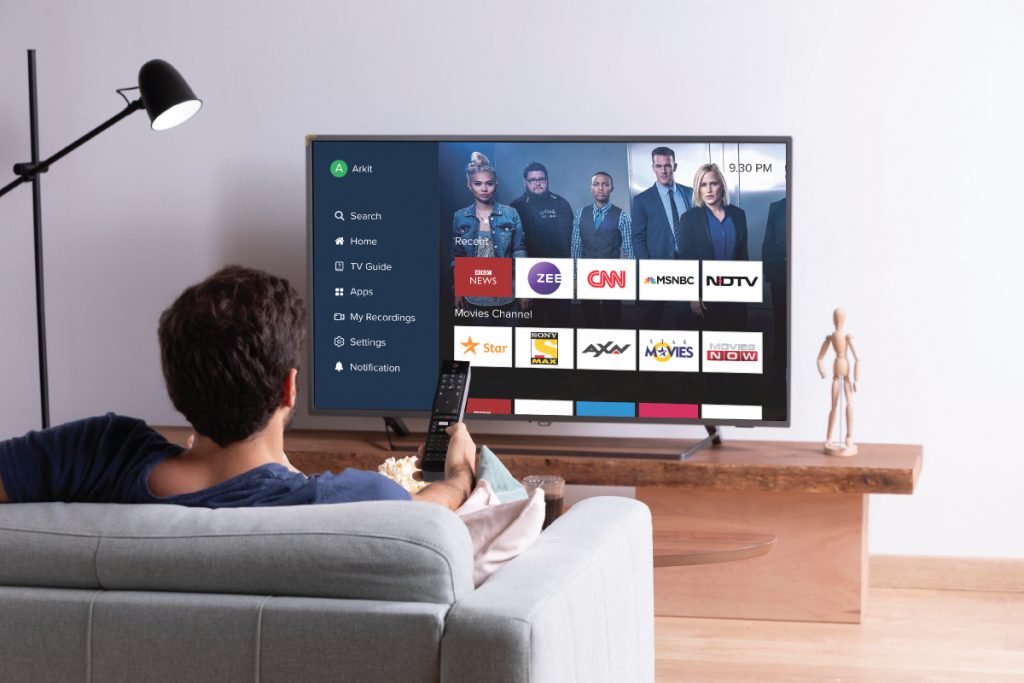
Top 3 Characteristics of Linear TV:
Rigid Schedule: Linear TV operates on a predetermined programming schedule. Viewers need to adhere to this fixed timeline to catch their favorite shows or events.
Real-Time Engagement: In contrast to on-demand streaming, linear television unfolds in real time. Viewers synchronize their watching habits with the programmed schedule to experience content.
Limited Viewer Control: A distinctive feature of Linear TV is the restricted control. Unlike OTT streaming services, users lack the ability to pause, rewind, or fast-forward content.
This limitation ties viewers to the linear progression of the broadcast.
Does anyone watch Linear TV?
According to Nielsen’s July 2023 report, linear TV viewership in the U.S. dipped below 50%, registering cable usage at 29.6% (a 12.5% YoY decline) and broadcast at 20% (a 5.4% YoY decrease).
In stark contrast, streaming services achieved a remarkable milestone, reaching a record high of 38.7%, marking a substantial 25.3% increase over the past year.
Key contributors to this surge included YouTube (9.2%), Netflix (8.5%), and Prime Video (3.4%).
The Benefits of Linear TV
Let’s see what benefits linear TVs offer in this section.
- Alignment with live events.
- Connection with older viewers.
- Precise targeting by channel and airtime.
- Repurposing ads for CTV campaigns.
- Flexible budgeting for broader reach.
- Channel integration is facilitated through retargeting.
Non-linear TV, like streaming services, has shaken up the TV world by letting viewers choose what to watch whenever they want. This gives advertisers a powerful yet easy way to target their ads.
But traditional TV still has its strengths. This is especially true for live events like sports and game shows where people can participate in real time.
Even though traditional TV can be expensive and tightly regulated, many consumers still trust the ads they see on it, which gives big brands what they always wanted — credibility.
However, with doubts growing about how effective digital ads are, TV is becoming a backup plan for brands looking for new ways to grow.
Advantages of Linear TV Advertising
Here are some advantages of linear TV advertising.
- Wider reach: Brands can reach a broad audience and different demographics – mass-market and narrow targets. TV advertising is still one of the most popular video formats, so it is widely perceived.
- High impact: Commercials can make a strong emotional and creative impact due to the audio-visual format, which is believed to be better for strong memories and brand recall. Viewers also perceive linear television as the most reliable and formal medium, which strengthens the emotional impact of the commercials.
- Targeted advertising: Despite being a mass medium, linear TV offers specific targeting, such as dayparts, genre, or TV programs, and channels. Thus, brands can better reach the audience with a specific demographic, interests or viewing habits.
- Credibility and trust: Ads on TV, especially on a good channel, are perceived as the most credible type of advertising. This keeps the brand image as trustful, high quality, and credible in the perception of the target audience.
Works together with the digital: Combining TV and online advertising campaign helps cover target audiences through both types of media.
Reaching audiences across multiple channels and platforms can yield maximum impact to the advertisers.
What is OTT TV?
OTT viewing refers to watching TV shows, movies, or other content over the internet. It bypasses conventional broadcast methods like cable or satellite.
With OTT, viewers have the flexibility and get to choose what to watch and when to watch it, often through subscription-based services like Netflix, Hulu, or Disney+.
OTT platforms deliver content directly to internet-connected devicesl ike smart TVs, computers, tablets, or smartphones, allowing for on-demand access without the need for a specific TV schedule.
This form of viewing has become increasingly popular due to its convenience and vast library of content choices.
Does Linear TV Still Have a Future?
Major industry players understand the need for a changing media landscape & show their willingness to adopt new technology.
Some have launched their own OTT services to take a higher leap of repurposing themselves & get their piece of the pie, such as Disney+, and NBC’s Peacock.
Other companies like Vodafone, and Viacom18 have decided to take linear television entirely to a new level by transforming their platform to Cloud TV.
Linear TV operators are now readily leveraging cloud TV that’s developed in cloud-based infrastructure to distribute their services as well as OTT streaming services.
All the more, it’s beneficial as they can also get access to digital technology in which advanced audience targeting & personalization are major takeaways.
But at the same time, they are also looking to maintain the scalability of linear TV. In simpler words, cloud TV brings the best of both technologies streamlined into one medium for operators.
Looking To Build Your Own OTT Video Platform?
Start and Grow Your Video Streaming Service With 1000+ Features & 9+ Revenue Models.
Highly Customizable
Life Time Ownership
Own 100% of Your Revenue
Full-Branding Freedom
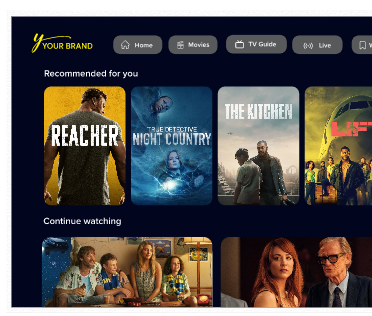
Transformation to Cloud TV:
Companies like Vodafone and Viacom18 take a pioneering step by transforming linear TV into Cloud TV.
This strategic move involves leveraging cloud-based infrastructure for the distribution of services and OTT streaming.
The shift to Cloud TV not only modernizes the linear TV experience but also opens avenues for enhanced scalability and technological integration.
The Synergy of Cloud TV:
Linear TV operators are consistently looking to make the most out of cloud TV, integrating advanced audience targeting and personalization of ads.
This approach allows them to maintain the scalability of linear TV while also cashing in on the perks of digital technology.
Overall, cloud TV is more like a synthesis of the best aspects of both technologies, providing a solution for operators.
What is OTT?
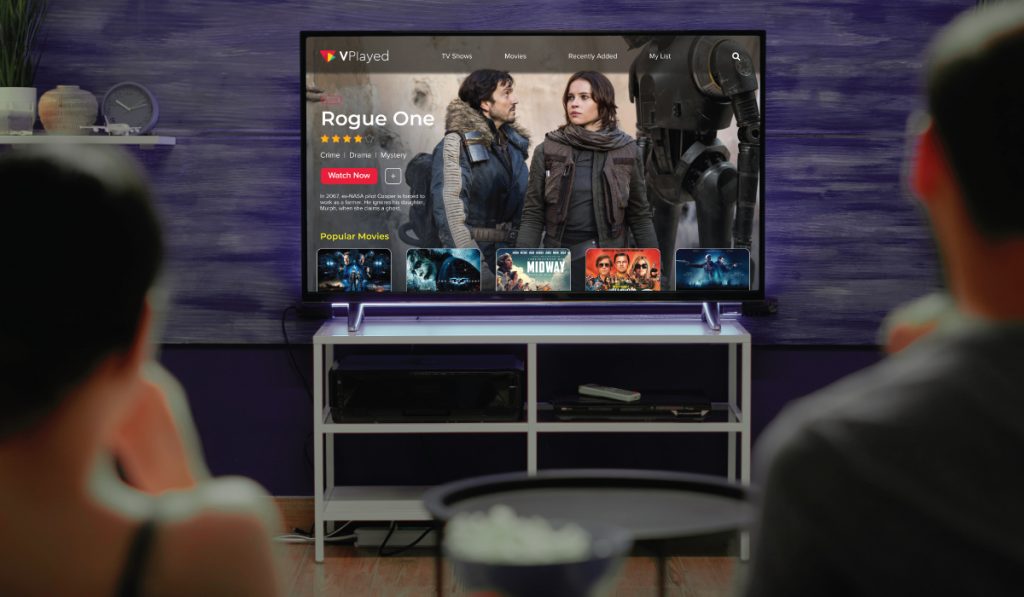
OTT is the short form for Over-the-Top television. It means delivering content (audio, video, and other forms of content) to a diverse audience across the world, spanning audio and video.
But, do you know how OTT differs from from conventional broadcast practices?
Unlike conventional televisions, where content is delivered via cables and satellite signals, in OTT the content is delivered via the Internet.
Now, this is a pathbreaking technology. Because it allows audiences to access content independently without needing cable or satellite service providers.
Of course, this is with an assumption that they already have a reliable network connection and a compatible hardware device that can stream to televisions or other Internet-enabled devices.
Smart TV devices like Apple TV, Amazon Fire TV, gaming consoles, etc., are the devices that primarily facilitate OTT streaming.
These devices are then paired to the HDMI port of TV streams where relevant content is streamed from popular OTT providers such as Netflix, Amazon Prime, Hulu, etc.
Smartphones or connected devices can download OTT apps which allows for real-time streaming — live or on-demand.
Key Aspects of OTT:
1. Internet-Based Content Delivery:
Basically, OTT content is distributed through wireless connections with the help of an infrastructure called, content delivery networks that are located across the world.
This makes it independent of conventional cable or satellite services.
In recent times, this freedom in content delivery has considerably changed the way audiences consume media.
The average consumer is no longer confined by the limitations of conventional, linear broadcasting.
An OTT platform offers a complete, diverse, and versatile experience tailored to modern viewing preferences.
2. OTT is Far More Convenient
Viewers can access OTT content at the time of their convenience — all they need is a stable internet connection.
By its virtue, OTT platforms provide the flexibility to tailor their entertainment to individual schedules.
This liberation from time and space constraints made OTT a runaway hit among the average consumer.
Global reach and also leads to a more personalized and immersive viewing experience for audiences worldwide.
3. Compatible Hardware Devices:
Illustrative of OTT devices are gadgets like Apple TV, Amazon Fire TV, and gaming consoles.
These tools establish a connection with TV HDMI ports, enabling the effortless streaming of content from well-known OTT providers such as Netflix, Amazon Prime, Hulu, and others.
4. Mobile Streaming Apps:
OTT applications seamlessly install on smartphones and connected devices, providing real-time streaming capabilities.
This flexibility allows users to enjoy their favorite content on the go, ensuring an on-the-move entertainment experience that aligns with the modern lifestyle.
Why OTT is So Popular?
OTT services give viewers complete control over consumption and unlimited access to high-quality content that’s viewable across various devices.
They can be customizable to enhance maximized viewing experience, & allow users to watch whatever they want from available titles.
With varied OTT packages, they can now easily gain the freedom to watch from anywhere at any time.
Viewers can pre-schedule their show time, & leisurely watch any genre of content with zero interrupted service.
This is very valuable for those, who can’t afford to view TV shows at a fixed time in a particular location.
There is also a possibility to pause content when watching shows & provide flexible viewing space for continued watching if necessary.
There are predictions that the cable television industry in the U.S. is forecasted to shrink by more than one-fourth by the year 2026.
This clearly shows that the OTT market is expected to boom further where the video segment is going to mount up to 3,508 Million users by 2027.
Indeed, this makes them one of the world’s significant sources of entertainment.
The OTT Advantage
Over-the-top is defined as long-form video content that is shown premium over the internet through an application or device such as TV, Smartphone, Web, PC, etc.
There is no need to subscribe to a wired cable, telco, or satellite service for users. OTT includes content that is streamed via popular apps like Netflix, Sling TV, Hulu, etc.
It’s a collection of video packages where anyone can access high-quality content once they pay for the subscription.
There are thousands of programs that audiences can easily procure access to via a monthly subscription.
It doesn’t just stop there, but OTT media provides complete freedom to access international web series, live sports telecasts, and favorite videos on the go.
This is one of the greatest pros for any target audience furnished from OTT streaming platforms.
Many consumers who devotedly watch linear TV, express their frustration at a number of adverts interrupting in-between the content.
While there are loads of ad occurrences a fact is predominant. Users have little interest in the ads shows & this is recognized by the advertisers as there is more need for creative, data-driven & accurate target OTT advertising experiences.
And the OTT environment gives them this opportunity.
Also, with the higher playback speed, it gets better with auditory & visual content as there is perfect sync due to smooth playability online.
Also, you can customize the video & audio quality according to your liking.
While you are the platform owner, you can manage entire operations on your own without any intervention from external sources & reap maximum profitability.
What is the Difference Between OTT and Linear TV?
Here are four key differences between OTT and Linear TV.
- The first difference is viewed from the perspective of the audience, and in particular what they watch. OTT platforms are oriented mainly toward on-demand watching. Thus, viewers can watch the film or series they want at the time when they need it, and they can do it as many times as they want. At the same time, all television and radio viewers have to watch a certain TV show at a certain time. OTT platforms give the audience certain opportunities and freedom that traditional television absolutely does not have.
- The second difference affects the content between these two types of channels, and over-the-top platforms usually contain a considerable amount of different pictures and series. Different apps contain films, series, talk shows, news, sporting events, and whatnot. The only thing that linear TV can offer is a limited number of channels with a limited number of topics.
- The third difference is the fact that 95% of all TV channels are watched on TV. Therefore, linear channels are trying to develop as the demand for television decreases each year.
- The fourth difference is that on TV, there are often annoying ads that the viewer does not want to watch. At the same time, on YouTube, viewers are offered to pay for content they do not want to see.
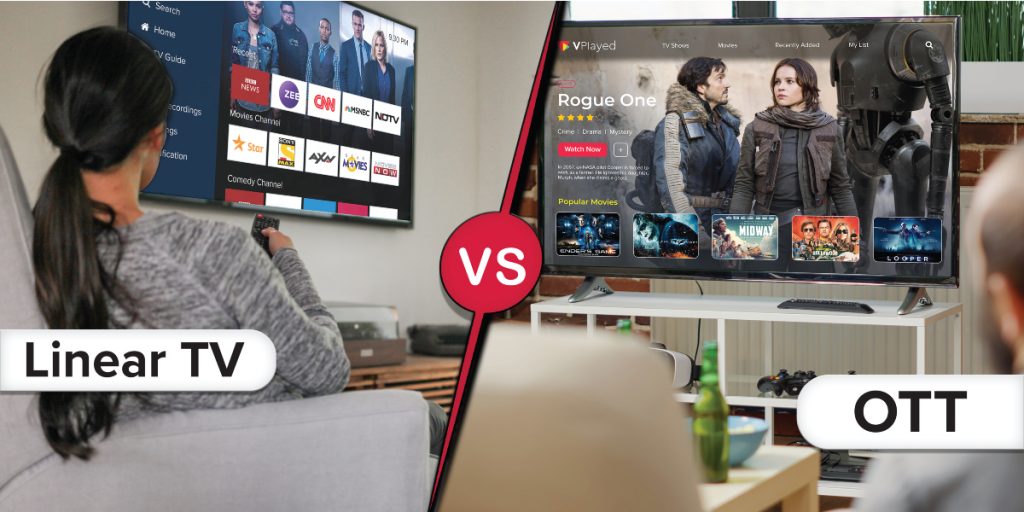
Here’s a summary of some of the crucial differences between linear TV and OTT TV.
| Aspect | OTT Platforms | Linear TV |
| Viewing Experience | On-demand watching, viewers choose what to watch | Scheduled programming, viewers watch at specific times |
| Content Variety | Wide range of content including movies, series, etc | A limited selection of channels with predetermined content |
| Platform Preference | Increasingly popular, flexible viewing options | Declining viewership, efforts to adapt to changing trends |
| Advertisement | Fewer or no traditional ads, subscriptions or ad-supported models | Regular commercial breaks, and ads often interrupt viewing |
| Audience Control | Viewers have control over what they watch and when | Viewers must adhere to the broadcaster’s schedule |
Linear TV
Scheduled Content Viewing:
Linear TV is when you watch TV shows or programs at specific times on certain channels, just like in the old days.
But unlike an OTT device, with a linear TV, you can’t record them to watch later; you have to tune in when they’re being shown.
This way of watching TV has been around for a very long time now and used to be fairly popular for advertisers to promote their products.
But you see, lately, fewer people are watching TV this way, so it’s not as popular as it used to be.
Some examples of linear TV include broadcast television networks such as ABC, NBC, and CBS. These TV channels offer a mix of news, drama, comedy, and sports programs, and viewers can generally only watch these programs in their scheduled time slots.
Additionally, linear TV also includes cable networks such as ESPN, HGTV, and MTV. These networks offer a more specialized programming focus and are typically available through a cable television subscription.
Challenges and Transformations:
While linear TV has its own share of audiences and continues to be significant to them, its prominence is lately challenged by evolving viewer preferences and the rise of alternative, fresh content consumption methods.
The dip in linear TV viewership indicates a shift towards more flexible and on-demand viewing experiences offered by contemporary OTT platforms like Netflix or Disney+.
Navigating the Evolving Landscape:
When we look at the pace of the evolution of streaming technology, linear TV has been adapting to remain relevant to quite some extent.
However, the main challenge lies in balancing the traditional broadcasting avenues with the demand for more flexible and personalized content consumption.
And, experts feel that this adaptation journey is more like a learning curve and it will continue to shape the future trajectory of linear TV viz-a-viz its prime threat, the OTT.
Over The Top (OTT)
Beyond Traditional Cable TV:
OTT, short for Over-the-Top, includes services that provide a diverse range of content within smoothly enabled delivery environments.
At its core, OTT represents a departure from traditional cable TV boxes. After all, it delivers video or audio content through the internet across the world.
This departure means users can now enjoy a more flexible and on-demand content consumption experience.
OTT as a Digital Medium:
The term OTT has evolved so much and it has now become synonymous with digital content delivery.
For instance, OTT TV apps can now distribute content to large-format screens, while the same asset can also be delivered in lower quality to older devices.
This adaptability coupled with versatility makes OTT an inclusive digital medium for media consumption.
Rise of OTT Services:
OTT has experienced a notable rise in its acclaim and popularity. Thanks to the advent of platforms such as Netflix, Amazon Prime, and others.
Numerous famous media entities like Sun Network, 21st Century Fox, and Zee Entertainment have ventured into the OTT space in the last decade.
Offerings like Disney+ and HBO underscore the media industry’s acknowledgment of OTT’s pivotal, extremely important role in shaping the outlook of content consumption.
⚡Also Read: How Does Amazon Prime Video Makes Money? ⚡
Hire Dedicated Developers to Develop Your Linear TV App
Developing a linear TV app can be complex due to compatibility requirements and the need to deliver content in real-time.
However, VPlayed’s hiring model simplifies this process, allowing you to assemble a dedicated development team tailored to your project.
We have a grand team of 300+ experienced OTT app developers who understand the intricacies of linear TV app development.
With our streamlined development process, we reduce time to market, ensuring your app reaches viewers faster and more efficiently.
Here’s how this approach transforms your app development experience:
- Flexible Hiring Model: Our hiring model allows you to scale your development team according to your project’s unique needs. We always ensure efficiency and cost-effectiveness at any time during the development cycle.
- Ready-to-Work Team: Our expert developers can start the work anytime, minimizing project delays and accelerating development.
- 300+ Experienced Developers: Our extensive team brings unparalleled expertise to every aspect of OTT TV/linear app development, thus ensuring high-quality results.
- Intuitive UI/UX Designs: We have assembled an amazing design team. Our designers prioritize user-friendliness with simplicity, consistency, and mobile responsiveness, improving the overall user experience.
- Multi-Device Support: We ensure seamless functionality across various devices and platforms, OTT broadening your app’s reach.
- Customize Anything On Your App: Enjoy complete customization freedom to align your linear TV app precisely with your brand identity and unique requirements.
- Faster Time to Market (3 to 4 weeks): Our streamlined development process often results in your app going live in just 3 to 4 weeks. In other words, it gives you a big competitive advantage in reaching your audience on time.
Note: All in all, working with VPlayed’s dedicated developers allows you to create fully customizable, reliable, and scalable linear TV and OTT TV apps.
Unlike other third-party developers, VPlayed ensures that your app seamlessly aligns with your vision, budget, and timeline, guaranteeing an exceptional streaming experience.
Conclusion:
Remember the days when we all sat together watching TV on a few channels with set schedules?
Well, those days are gone.
Thanks to streaming services, things have changed a lot in the tech as well as in the entertainment field.
Now, we have better and constant Internet connections, and the way we watch content has totally flipped. We are not stuck with the old-style TV broadcasts anymore.
People now use high end gadgets that have the latest tech – phones, tablets, computers, and smart TVs. Everyone can decide what, when, and where they want to watch, with just a click.
It’s no longer about families gathering around a TV; now, each person has their own smart device and can watch what they like, whenever they like.
This change is making big TV networks or media companies think of new ways to attract viewers and give them the best service possible.
All in all, we can say that TV isn’t just for families anymore; it’s a personal thing. As tech keeps getting better, the way we watch TV is getting better and better.
And big TV networks need to find alternate ways to keep people interested and hooked in front of the screen.
- Request Demo Book a Live, Personalized Demo
- Contact Sales Reach Out to Our OTT Experts
Frequently Asked Questions (FAQ)
1. What are Linear TV Platforms?
Linear TV is the traditional way of watching a scheduled TV show on its original channel. Viewers can also record and watch later. While it still has a significant market share, the audience is spread out as TV competition increases.
2. What are the advantages of Linear TV?
The top 3 advantages of Linear TV are as follows:
1. Targeted audiences based on channel and time, matching demographics to programming.
2. Mass reach exists since users often pay for linear TV in addition to streaming subscriptions.
3. Linear TV dominates in sports or live game shows where the public participates by voting.
3. What is the difference between linear TV & OTT?
Linear TV is the traditional method where viewers watch a recorded show on its channel. OTT delivers content over the internet based on individual preferences. Linear TV caters to all ages, while OTT focuses on young adults aged 18 to 29.
4. What Is Linear TV Advertising?
Linear advertising follows a set schedule, running ads at specific times to target particular audiences. This allows advertisers to reach specific demographics by choosing channels and airtimes where their target audience is likely to watch.
5. What are the advertising benefits of Linear TV?
Linear TV still offers the largest viewership, providing advertisers with the broadest reach to introduce their brand to new consumers. Some of the benefits of Linear TV include Reaching undiscovered audiences, avoiding ad fatigue, testing and adjusting advertising efforts, and optimizing reach.
